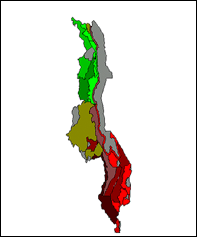Has been widely used in East and Central Africa:
- Baseline information for the UN operation lifeline Sudan
- WFP for assessment and prediction of the needs of displaced in Somalia, Burundi, Afghanistan.
- FAO for assessing food needs in Somalia
- UNHCR for assessing the food needs of refugees in East Africa
- Governments such as Rwanda, Tanzania, Malawi and Ethiopia - national assessments to identify needs in drought or conflict situations.
- Supporting and complementing various approaches used by other agencies and governments, including SADC, FEWSNET, VAM, FIVIMS
b) Key Terms and Principles:
- Food Economy Zones
 |
- An FEZ is a geographic area in where the majority of households obtain their food and cash income through similar combination of means.
- The HEA database divides Malawi into 21 different FEZ’s.
- The populations in each of these zones have access to similar economic opportunities.
|
- Baseline or Reference Year
- Frequently occurring: “typical”, “usual”, “normal”. Not necessarily “good”
- Minimal “coping”
- Puts “a shock” year into perspective
- Usually begins with the main harvest (eating green) in an agricultural economy
- Wealth Groups
- Sets of households who have similar levels of assets, employ similar strategies to gain access to food and cash income
- Within a wealth group households will be affected by, and respond in similar ways to, a given shock
- Wealth is a relative term
- Sources of Food, Income .and Expenditure
- Sources of Food:
- The means (or activities) through which a household gains the food it consumes
- Sources of Income:
- The means (or activities) through which a household gains cash
- Expenditure:
- Includes food (staple), food (non-staple) and non-food
|






